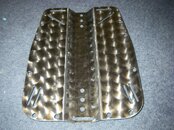You need a sheetmetal brake to kame any of the bends. A shear is also needed to cout the outline.
I've made aluminum plates in the past. For thos I just chain drilled the slots and cleaned them up with a file.
For stainless you need a mill to machine the slots.
I made them, because I had some material. Over time, during lunch breaks I've gradually worked on them.
They're fun to make, but you need access to some tooling.
I have some aluminum that's already cut and bent for a single tank adaptor.
That would make a good project that's able to be done with hand tools.
Just drill the holes, and chaindrill the slots. 3/8" drill for the holes, and. Either 1/8" or 1/4" for the slots.
I'll mail you a couple if you want them. I think I have your address from when I bought a can light from you. ;-)
To make a plate really isn't worth it. I just did a few for the hell of it, but considering how cheap they are to buy.
I wouldn't recommend making one, especially out of stainless.
The ones you can buy, are worth buying.
A single tank adaptor makes a good DIY project.
I'll send you a couple.
-Mitch





